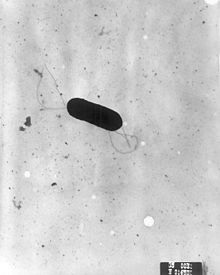| Listeriaceae | |
|---|---|
 | |
| Listeria monocytogenes | |
| Scientific classification | |
| Domain: | Bacteria |
| Phylum: | Bacillota |
| Class: | Bacilli |
| Order: | Bacillales |
| Family: | Listeriaceae Garrity et al. 2001 |
| Genera [1] | |
| Synonyms | |
| |
The Listeriaceae are a family of Gram-positive bacteria that includes two genera: Listeria and Brochothrix. [2] [3] [1] They are short, rod-shaped bacteria that are aerobic or facultatively anaerobic. [2] Spores are not formed, but under stress these bacteria can form filaments. [2] Some species, namely Listeria monocytogenes , can cause human and animal listeriosis. While not all bacteria in the Listeriaceae family are considered a danger to humans, some are strongly associated with food borne illness or microbial spoilage, so they remain a topic of interest in agricultural industries. [2]